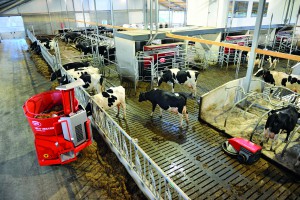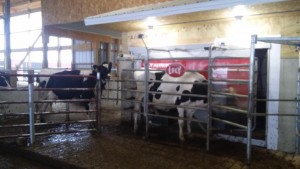Robotic milking will work in most barn layouts, but certain design features improve traffic flow, cow comfort, and the overall success of a robotic milking facility.
Jack Rodenburg with DairyLogix Consulting in Ontario, Canada, presented, “Barn design for robotic milking,” in a recent Hoard’s Dairyman webinar sponsored by Lely North America.
“Robotic milking can do a tremendous amount to reduce dairy farm labor,” Rodenburg said. “If properly implemented, robots can reduce labor in the barn by as much as 30 to 40 percent.”
In order to make robotic barns successful, owners need to consider these issues with barns designs:
First, provide facilities for efficient separation and handling of individual cows.
 “Even if farmers aren’t milking any more, they may spend extra time moving cows around if they haven’t thought about an efficient way to handle individual cows,” he said.
“Even if farmers aren’t milking any more, they may spend extra time moving cows around if they haven’t thought about an efficient way to handle individual cows,” he said.
Secondly, consider an area for special needs cows, such as fresh cows or lame cows.
“You would like to have those cows in an area of the barn, close to the robots, where they are going to thrive,” Rodenburg said.
Third, sometimes we fail to recognize the importance of behavior and social rank of cows. This can affect how cows move through the system.
Free-Cow Traffic
When building a robot barn, a producer must decide between a free-cow traffic or guided-traffic design. In free-cow traffic barns, cows have access to feeding and resting areas with no restriction.
“I design barns for both, but for me, cow comfort is absolutely key,” he said. “For that reason, I have a strong preference for free traffic.”
The key to managing free-cow traffic systems is to have adequate space in front of robots. Rodenburg recommends 20 feet from the milking box to the first free stall. He also recommends locating cow brushes, computer feeders and pasture selection gates far away from this area to spread out barn activity.
Rodenburg identified 12 key barn design considerations including:
- Free-traffic
- Open space in front of robots
- Footbath lane
- All robots should face the same way
- Simple routes for fetching
- Simple routes from group to group
- Handling chute
- Gating for one -person handling
- Flexible separation area
- Fresh and lame pack
- Stress free calving line
- Perimeter feeding
To watch the full robot barn design webinar, visit www.hoards.com/webinararchives_16-jun
